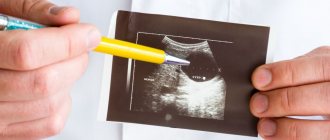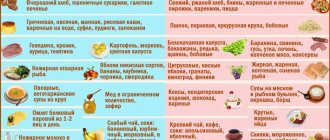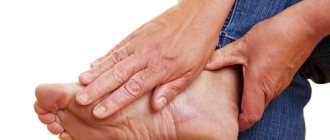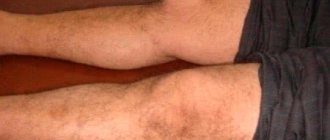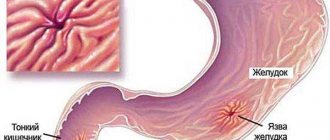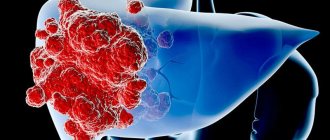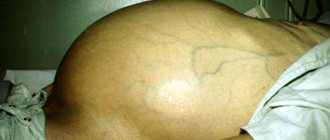Steatosis, or fatty liver, is a pathological condition in which fat accumulates in the hepatocytes in the form of droplets. So much fat can form that the hepatocyte ruptures, and fat accumulates in the intercellular space in the form of fatty cysts, disrupting the structure of the liver.
This is a common disease that can occur even in childhood, but people over 45 years of age are most susceptible to it; women more often than men suffer from non-alcoholic steatosis, men - from steatosis that developed as a result of alcoholism. Liver steatosis can be an independent pathology, or a symptom of some other primary diseases (for example, type 2 diabetes mellitus).
What is hepatic steatosis?
Steatosis is a type of hepatosis, the main manifestation of which is fatty degeneration of hepatocytes. It can be an independent disease or a syndrome of another pathology. Steatosis is characterized by the accumulation of fat droplets by hepatocytes.
When fat accumulates, cells can rupture. Lipids fill the spaces between cells, and cysts form in the parenchyma. Over time, cysts grow with connective tissue. Severe liver failure increases, with further death.
Who most often gets this disease?
- Women over 45 years of age who are overweight.
- Men over 45 years of age who abuse alcohol.
Risk factors
- obesity;
- age over 45 years;
- alcohol abuse;
- type 2 diabetes mellitus;
- genetic predisposition;
- female.
Nutrition and diet
If you have a fatty liver, you need to eat frequently, in small portions. The daily diet includes easily digestible foods high in B vitamins, amino acids and protein. Fatty and carbohydrate-rich foods should be excluded from the diet. The menu should contain dishes based on the following food products.
- — Skim milk and fermented milk products.
- - Vegetables.
- - Fruits low in sugar.
- - Whole grain porridge.
- - Bran.
- - Low-fat varieties of meat and fish.
- — Seafood.
- - Dried fruits.
It is better to replace animal fats with vegetable ones. To quench your thirst, drink mineral water without carbon or green tea without sugar.
It is important to know! The consumption of alcoholic beverages is contraindicated for any type of hepatosis and degree of obesity!!!
Reasons for the development of steatosis
- Alcohol abuse.
- Disturbance of carbohydrate metabolism.
- Violation of fat metabolism.
- Genetic predisposition.
- Diabetes.
- Thyroid diseases.
- Pathologies of the gastrointestinal tract (GIT).
- Obesity.
- Pregnancy.
- Previous surgical operations on the gastrointestinal tract.
- Itsenko-Cushing syndrome.
- Effect of toxic substances (carbon tetrachloride, insecticides, organophosphorus compounds).
- Toxic effects of heavy metals.
- Previous liver injuries.
- Exposure to medications during long-term use (tetracycline antibiotics, anti-tuberculosis drugs, corticosteroids, cytostatics, etc.).
- Malabsorption syndrome.
- Deficiency of the enzyme that breaks down fats (lysosomal acid lipase).
- Hepatitis.
- Strict diet.
- Veganism.
Prevention of hepatosis
Hepatosis most often occurs as a result of excessive alcohol consumption and poor diet.
Less common causes are endocrine disorders, exposure to organophosphorus compounds, insecticides and other toxic substances. The greatest danger to liver cells is alcohol. Persons who abuse it usually do not eat properly, so two unfavorable factors act on the liver at once.
During the treatment of certain diseases, such as tuberculosis, drug-induced liver steatosis often develops. The reason is that the patient uses antibiotics, hormonal drugs and other medications. The lack of oxygen that the liver experiences during tuberculosis and other pulmonary diseases also plays a role.
Endocrine diseases are another cause of steatosis. At risk are older people, primarily those with diabetes. Fatty liver can also develop with disorders of the thyroid gland, with obesity, with a deficiency of vitamins and microelements.
It is very important that the diet is balanced: the content of animal proteins should not be excessive or insufficient against the background of the total calorie content. Patients suffering from chronic pancreatitis develop steatosis much more often than those who do not have chronic diseases of the digestive tract. According to statistics, every fourth patient suffering from chronic pancreatitis develops steatosis. It is also often found in people with heart and vascular problems.
Symptoms of liver steatosis
Steatosis is usually a chronic disease. Symptoms increase very slowly. In grade 1, they are absent, but if they are detected, it is often by chance, during examination for another reason.
Symptoms that may occur with grade 2 steatosis:
- increased fatigue;
- loss of appetite
- nausea;
- heaviness in the hypochondrium on the right;
- general weakness;
- colds due to decreased immunity.
Signs of the disease in later stages of development:
- intense pain in the hypochondrium on the right;
- a feeling of compression in the hypochondrium on the right;
- itching;
- jaundice;
- bitterness in the mouth;
- nausea;
- vomiting with bile;
- skin rash;
- diarrhea;
- yellowness of the sclera;
- sleep disturbance;
- manifestations of lipid metabolism disorders on the skin and mucous membranes (xanthomas, xanthellasmas, lipoid arch of the cornea);
- deterioration of attention.
Symptoms and signs
Fatty hepatosis of the 1st degree develops latently, without the occurrence of pronounced manifestations. This stage proceeds rather slowly over a long period of time. The disease can be diagnosed in such cases during studies to identify other pathologies.
The first stage of the disease is characterized by general symptoms:
- general malaise;
- causeless weakness;
- nausea.
With the further development of steatosis, a feeling of heaviness appears in the right hypochondrium, the size of the organ increases, which can be noticed upon palpation. There is a pain symptom from the liver. The possibility of developing colds and other infections increases due to a decrease in the protective function.
If the process of outflow of bile fluid is disrupted, symptoms of cholestasis occur:
- change in skin color to a yellowish tint;
- itchy syndrome on the epidermis;
- intense pain syndrome from the organ;
- nausea and vomiting syndrome with the presence of bile impurities in the vomit.
Attention! The last degree of the disease is characterized by complete obesity of the organ, which leads to the cessation of its functioning.
Types of disease
In relation to alcohol abuse:
- alcoholic;
- non-alcoholic.
Alcoholic steatosis is considered to be the steatosis that develops in a patient due to alcohol abuse.
Non-alcoholic liver steatosis is a lipid transformation. It occurs with concomitant diseases, nutritional defects, and poor lifestyle.
Based on the structure of liver damage, diffuse and focal steatosis are distinguished:
- Diffuse steatosis - all liver cells are involved in this process.
- Focal steatosis - fat is located in hepatocytes in certain areas of the organ.
In turn, the focal form of the disease is divided into:
- Focal disseminated - a small number of hepatocytes in various parts of the liver accumulate lipids. There are no symptoms of damage.
- Pronounced disseminated - a large accumulation of fatty droplets in many parts of the organ. Symptoms of damage appear.
- Zonal - lipids are deposited in hepatocytes in a certain zone (lobule).
There is another form of lesion – focal steatosis. It is characterized by the presence of benign tumors of various locations in the tissues of the organ. It is found by chance during examinations. There are no clinical manifestations.
Degeneration of the liver into cirrhosis
For etiological reasons, liver steatosis is divided into:
- Primary – congenital disorder of metabolism (metabolism).
- Secondary is a metabolic disorder that is a consequence of the underlying disease, poor diet and lifestyle.
According to pathological changes at the level of the liver cell, the following are distinguished:
- Small droplet steatosis - accumulation of small droplets of fat in the cells. There is no damage to liver cells.
- Large droplet steatosis - accumulation of large droplets of fat occurs in hepatocytes. Damage to hepatocytes occurs. Subsequently, the liver cell dies.
Classification of the disease by morphology:
- Grade 0 – small accumulations of fat in some liver cells.
- First degree - foci of cells with lipid inclusions appear. They merge with each other, damaging cells (up to 33% of changed cells in the microscope field).
- Second degree - accumulations of fatty inclusions are distributed diffusely throughout the liver tissue (from 33 to 66% of all hepatocytes in the microscope field).
- Third degree - fat accumulates not only within the cell, but also in the intracellular space. Cysts form. Hepatocytes are destroyed and die (up to 66% of all hepatocytes in the microscope field).
a brief description of
Steatosis is a violation of the filtration function of hepatocytes. The disease was classified as a dystrophic disorder of liver function consisting of infiltration and exfiltration of fats in 1980.
It is necessary to differentiate between steatohepatosis and steatosis. Steatosis – no inflammatory process, fluctuation in body weight towards an increase of no more than 8%. Fatty hepatosis - body weight exceeds 50% is poorly treated, often accompanied by severe inflammatory processes and pain.
Prevalence and significance
Steatosis is most common in North America and Western Europe due to massive consumption of fast food. The disease does not occur on its own. It is the cause of gastrointestinal dysfunction or excess fluid in the body. Alcoholism is an independent disease.
Steatosis is the root cause of the accumulation of heavy metals and chemical vapors in the body, which is fraught with cancer. It provokes pancreatic diseases, obstructs the outflow of bile, and aggravates excess body weight gain.
Also, the occurrence of benign tumors, both in the liver and genital appendages. Accompanied by significant swelling of the extremities - blood clots, venous bleeding.
In the second stage, it is almost impossible to restore metabolism.
Risk factors
Risk factors should be understood as conditions that can provoke the occurrence of causes leading to disruption of hormonal balance, the balance of gastrointestinal microflora, and metabolism in general.
- Inadequate nutrition.
- Consumption of alcohol and other toxic substances.
- Sedentary lifestyle.
- Excessive stress on the abdominal muscles, injuries to the pancreas, stomach, liver.
- Hypothermia of the abdominal organs and kidneys.
- Drug treatment.
- Diets inconsistent with the nutritionist and/or attending physician.
Stages of the disease
There are three stages:
- Stage 1 (minimal obesity) – lipids accumulate in hepatocytes without damaging the cells themselves.
- Stage 2 (moderate obesity) – irreversible processes of cell death begin in hepatocytes. Lipids from them penetrate into the intercellular space. Cysts form.
- Stage 3 (severe obesity) – a precirrhotic state occurs. The affected liver cells begin to grow into fibroblasts (connective tissue cells).
Choleretic
With fatty liver degeneration, there is a violation of the outflow of bile, which leads to indigestion and constipation. To speed up the flow of bile enzymes into the duodenum, choleretic drugs are taken. The treatment regimen for liver hepatosis includes:
- Galstena is a homeopathic medicine of combined action that stimulates the excretion of bile. It has antispasmodic and anti-inflammatory properties. Dissolve 1 tablet 30-40 minutes before meals. For liver disorders, take at least 3 weeks in a row.
- Allochol - accelerates the flow of bile acids through the bile ducts and also prevents the precipitation of cholesterol. For liver dysfunction, you need to take 2 tablets 2-3 times a day.
- Cholenzyme – stimulates bile synthesis, increases the level of bile acids. When treating hepatosis, 1 tablet is prescribed up to 3 times a day.
- Odeston - accelerates the biosynthesis of bile and its release into the lumen of the small intestine. Take 1 tablet three times a day before meals.
- Tanacehol - restores the biochemical composition of bile and accelerates its movement into the duodenum. The daily dose is 6 tablets, divided into 3 doses.
When treating dystrophic processes, drugs that stimulate bile secretion are taken with caution. Abuse of drugs that stimulate bile synthesis can worsen steatosis.
Diagnostics
Non-instrumental examination methods:
- Collection of complaints.
- Collecting anamnesis of illness and life.
- Family history.
- Patient's nutritional history.
- Examination of the patient.
- Determination of body mass index.
- Determination of ideal body weight.
- Determination of the ratio of hip circumference to waist circumference.
Laboratory examination methods:
- General blood test (an increase in ESR, a decrease in red blood cells and hemoglobin is detected).
- Blood biochemistry (increased transaminases, increased cholesterol levels, increased blood sugar, decreased albumin are detected).
Liver steatosis on CT
Instrumental research methods:
- Ultrasound (determine structural changes, identify cysts).
- CT (determine changes in structure, determine the extent of damage).
- MRI (assessing the degree of liver enlargement and changes in liver tissue).
- Laparoscopy (allows you to examine the organ and take tissue for a biopsy).
- Liver tissue biopsy (determining the degree of fibrosis, presence of cirrhosis).
- Isotope scanning (determines the functional state of the organ).
- Elastography (determines the degree of organ fibrosis).
Treatment: drugs, folk remedies
Do not forget that any symptom inherent in steatosis is a reason to immediately consult a doctor. Only he can prescribe the correct diagnosis of the disease and adequate treatment. So, what is the treatment for this insidious disease? The initial task of the specialist is to identify the cause of its occurrence, that is, those factors that negatively affect the liver, causing this disease.
Most often it is difficult to determine the cause. But gastroenterologists are well served by the problems indicated in the patient’s medical history. These include, for example, alcoholism, diabetes, and excess body weight. Treatment can be carried out without going to the hospital, if you follow all the recommendations of the treating doctor and respond to the symptoms in a timely manner. But if there is an exacerbation, the patient must be admitted to a hospital, physiotherapy, medications, bed rest and everything that is needed for recovery are prescribed.
Medicines
Doctors prescribe such modern, effective drugs as:
- vitamins B12, B4;
- lipoic acid;
- methionine;
- antibiotic metronidazole;
- folic acid.
In addition, hepatoprotectors definitely come to the rescue. This:
- Heptral;
- Karsil;
- Essentiale;
- other drugs that perform liver protective functions.
When treating steatosis, it is very important to follow a special diet, which primarily involves reducing fat intake to a minimum. Doctors also advise patients on certain physiological procedures. Among them are useful and necessary:
- the effect of ultrasound on the patient’s body;
- ozone therapy;
- spending time in a pressure chamber.
If liver steatosis has not developed to stage 3, doctors will be able to treat it. If the disease has already reached this stage, then everything is much more complicated. All that can be done is to eliminate the influence of the provoking factor, prescribe special medications that will help prevent further decay of liver cells and the transition to liver cirrhosis. If the disease progresses to cirrhosis (this happens in 15% of cases), the person has about 5-10 years to live.
Traditional treatment
If the doctor sees that folk remedies can help in combination with medications, he prescribes them. Let's look at a few effective recipes.
- Bran. Including bran in your diet will help fight fatty deposits in the liver. They need to be poured with 200 ml of boiling water, then cooled and strained. You need to consume two spoons three times a day.
- Apricot kernels. They are very useful for patients with steatosis, because the seeds contain a large amount of vitamin B15. In order for the liver to start working properly as quickly as possible, doctors recommend consuming seven kernels throughout the day.
- Medicinal cocktail. The ingredients that make up this cocktail are carrot juice, warm milk. You need to take one hundred milliliters of each of the components and connect them together. You should drink on an empty stomach, in small sips 30 minutes before meals.
- Herbal decoctions. Let's look at another good recipe. You need to take crushed dandelion roots and milk thistle seeds in a 1:1 ratio. Then you need to add to them a tablespoon of goldenrod, dried nettle leaves, and birch leaves. The prepared raw materials should be poured into a thermos and filled with boiling water. Infuse the decoction for about 20 minutes, then filter, drink 200 ml in the morning and evening.
Treatment of liver steatosis
Can hepatic steatosis be cured? When a diagnosis of liver steatosis is made, the main thing is to neutralize or remove the etiological factor. Alcoholic liver steatosis requires avoidance of alcoholic beverages.
- It is necessary to reduce excess weight and eat rationally.
- Compensate for the underlying disease if it leads to steatosis.
- It is necessary to avoid taking medications that caused the disease.
- Avoid exposure to toxic substances.
For liver steatosis, therapy should only be prescribed by a specialist gastroenterologist or hepatologist.
Drug treatment of hepatic steatosis
There is no specific treatment for the disease. Treatment is aimed at reducing the effect of the etiological agent that caused the disease. The goal of therapy is to maintain the patient's compensated condition. Therapy is also aimed at the general strengthening of the patient’s body.
Treatment goals for hepatic steatosis:
- Protect liver cells from the action of factors that destroy them.
- Restore the functions and structure of the organ.
- Increase the sensitivity of body cells to insulin.
- Reduce lipid levels.
- Will reduce body weight.
- Protect cells from peroxidation processes.
- Increase the resistance of hepatocytes to oxygen starvation.
The following groups of drugs are used in treatment:
Hepatoprotectors.
- Phospholipids (Phosphoglyph, Essentiale Forte, Antralife, etc.).
- Herbal preparations (Legalon, Karsil, Allohol, etc.).
- Preparations containing ursodeoxycholic acid (Urdoxa, Ursosan, etc.).
- Preparations containing amino acids (Hepa-merz, Heptor, etc.)
Hypoglycemic drugs.
- Statins (Rosuvastatin, Simvastatin, etc.).
- Fibrates (Clofibrate, etc.).
Drugs that reduce body weight.
Antioxidants (Vitamin A, Vitamin E, Mexidol, etc.).
Antihypoxants (Actovegin, Carnitine, etc.).
Treatment of liver steatosis with folk remedies
Treatment with traditional methods
How to treat liver steatosis with folk remedies? When treating with folk remedies, the following are used:
- bran steamed with boiling water;
- decoction of corn silk;
- dandelion root decoction;
- decoction of calendula leaves;
- plantain decoction;
- elecampane decoction;
- celandine decoction;
- meal decoction;
- milk thistle oil.
Herbal decoctions are used for a long time in treatment. The course of treatment is at least a year.
Treatment of fatty hepatosis
Treatment of fatty hepatosis mainly comes down to lifestyle changes - switching to proper nutrition, reducing alcohol consumption, and increasing physical activity. The whole set of measures is aimed at normalizing energy metabolism in liver cells, protecting cell membranes from destruction and stabilizing the functioning of the liver as a whole. Therefore, the patient must remember that the first priority is to rid the liver of fats.
Usually the treatment ends successfully, but after it the body may need long-term support in the form of special procedures.
Prevention of steatosis (hepatosis) is quite simple:
- You should eat properly and balanced;
- Treat diseases of the stomach and intestines in a timely manner, preventing them from becoming chronic;
- If possible, avoid the effects of toxic substances on the liver, especially alcohol.
- In case of long-term use of hormones, you should additionally take medications designed to protect the liver and improve its function.
The main groups of pharmacological agents that are used in the treatment of liver diseases are hepatoprotectors : Ursosan, Liv 52, etc. For such preparations, as a rule, a high-quality natural base is used, for example UDCA. If you follow the instructions for use, you can direct their action to protect liver cells, and, above all, to stabilize their membranes.
Directly to improve fat metabolism at the cellular level, the drug Ursosan is prescribed.
Special drugs from the group of statins have a more powerful effect in terms of normalizing fat metabolism, but as a side effect they themselves can increase the activity of transaminases.
Therefore, in cases where they are obviously elevated (steatohepatitis) or increase during treatment, the use of Ursosan is necessary.
Diet for liver steatosis
The main goal of the diet is to remove lipids that are deposited in hepatocytes.
The principles of the diet are as follows:
- Normalization of organ function.
- Normalization of cholesterol metabolism.
- Stimulation of bile acid production.
- Normalization of lipid metabolism.
- Creation of glycogen depot.
- Hepatocyte regeneration.
A diet for steatosis excludes the following foods:
- Fried, fatty foods.
- Hot spices.
- Fatty fish.
- Duck, goose.
- Sorrel, spinach.
- Fat meat.
- Mushrooms.
- Sausages.
- Soda, lemonade.
- Fatty broths.
- Marinades and smoked meats.
- Nuts.
- Pickles and canned food.
- Cocoa, coffee.
- Alcohol.
- Confectionery.
- Chocolate.
- Snacks and chips.
Diet for steatosis
How to change your lifestyle
First of all, it is necessary to exclude all factors that may affect the further development of liver steatosis, regardless of its type and the degree of damage to the organ.
You need to start with physical activity. As a result of regular training, the body's sensitivity to insulin increases and fatty tissue decreases. However, it should be remembered that if you lose weight too quickly, the likelihood of complications increases sharply.
The optimal training regimen is a half-hour workout, which consists of aerobic exercises. You need to repeat the complex three times a week. In this case, a person can consistently lose up to 1000 g per week, and the body mass index decreases by an average of 8-10%.
Nutrition for steanosis
The main therapeutic diet prescribed for steanosis is table No. 5. The main goal of dietary nutrition is to provide the body with a full range of useful substances that stabilize the functioning of the liver and normalize the flow of bile.
What products are allowed for consumption for steatosis:
- First courses: milk with pasta, vegetable with cereals, lean borscht, beetroot soup.
- Meat and poultry: lean beef or lamb, rabbit or turkey.
- Fish: boiled low-fat varieties, fish meatballs; after boiling, the fish can be baked.
- Cereals: first of all, the menu should include oatmeal and buckwheat porridge; you can cook vegetable pilaf and pasta.
- Fats are only vegetable and refined.
- Dairy products: low-fat cottage cheese, kefir, low-fat cheeses with a neutral taste, low-fat sour cream and milk.
- Eggs: omelette only made from whites, soft-boiled eggs, no more than one yolk can be consumed per day.
- Vegetables: you can eat them in any form - boiled, baked, fresh, stewed, you can cook any vegetable dishes.
- Bakery products: rye bread, crackers, shortbread cookies.
- Appetizers: salads - seafood or fruit and vegetable salads.
- Other products: dried fruits, honey.
- Drinks: green tea, coffee with milk, rosehip infusion, natural juices.
Lenten borscht
Beetroot
Eggs
Fish
Porridge
Dairy
Vegetables
Salads
The choice of products is quite extensive, so creating a varied and tasty menu is not difficult. An approximate menu for four days is presented in the table.
| Day of the week | Breakfast | Afternoon snack | Dinner | Dinner | Before bedtime |
| The first day | Fruit salad, steamed beef cutlets, coffee with milk | Kefir | Lenten borscht, boiled hake with stewed vegetables, berry jelly | Spaghetti with cheese, glass of mineral water | Banana |
| Second day | Protein omelet, rye bread toast, compote or juice | Pear | Cream vegetable soup, boiled chicken with vegetables, uzvar | Puree, tea | Borjomi |
| Day three | Stewed rabbit, tea | Morse | Vegetable soup, cheesecakes, jelly | Protein omelet, cheese, tea | Kefir |
| Day four | Pilaf, cottage cheese casserole | Apple and carrot salad | Buckwheat porridge with chicken or fish meatballs, compote | Potato zrazy, cabbage salad, baked fish, mineral water | Baked apples |
Of course, diets are followed only in conjunction with physiotherapeutic procedures and a course of medications. It is not recommended to create a diet on your own; you should consult a specialist.
The main goal of dietary nutrition is to achieve stable remission, stop exacerbations, and normalize the functioning of internal organs. In addition, the diet allows you to lose weight, improve overall well-being, and a feeling of energy volume appears.
If, in addition to liver steatosis, the patient is concerned about bile pathologies, it is necessary to completely avoid harmful foods, not only during the period of treatment, but also after the end of therapy. First of all, you need to give up smoked foods, spicy foods and alcohol. Otherwise, the effect of treatment is minimized and the therapy will have to be repeated.
Complications of the disease
- Steatohepatitis – due to fatty infiltration, inflammation of the liver tissue begins. The disease is more severe. If there is no treatment in hepatocytes, the processes of apoptosis and necrosis.
- Fibrosis – the liver gradually loses its structure. Instead of liver parenchyma, connective tissue grows. The organ loses part of its function
- Cirrhosis – necrosis of almost all hepatocytes occurs. The filtration functions of the liver cease to be performed. This condition is irreversible.
Bibliography:
- Fatty liver disease: a modern pathogenetic approach to therapy. V.M. Makhov, T.V. Volodina, A.S. Panferov. First Moscow State Medical University named after. THEM. Sechenov. - Medical advice. No. 09, 2021.
- Shukevich T.M., Pomytkina T.E., Mozee K.B. Alcoholic liver disease - key issues in the epidemiology and pathogenesis of the disease. — Medicine in Kuzbass. T. 19 No. 1, 2021.
- Alcohol disease. Damage to internal organs / Ed. V.S. Moiseeva. — 2nd ed. reworked and additional - M.: GEOTAR-Media, 2014. - 480 pp.: ill.
- Gastroenterology: national guide / Ed. V.T. Ivashkina, T.L. Lapina - M.: GEOTAR-Media, 2008. - 704 p.
Forecast
In the initial stages of its development, the disease has a favorable course. Late stages of the disease are difficult to treat if the processes of hepatocyte degradation are already irreversible.
When treating initial forms of steatosis, a positive effect can be achieved within a few months, provided that the patient follows the doctor’s recommendations on diet and treatment.
Complete abstinence from alcohol is important for alcoholic steatosis. With non-alcoholic hepatosis, the patient must reduce weight and follow a diet.
Concomitant diseases must be compensated. All other pathological factors were neutralized. If these conditions are not met, complications will develop. The outcome of complications is unfavorable. A fatal outcome from complications of this disease may be due to the occurrence of liver failure and portal hypertension syndrome with bleeding from varicose veins.
Possible consequences
Prolonged ignorance of clinical signs and refusal to change the patient’s usual lifestyle can lead to complications in the event of ongoing stenosis of the liver and pancreas.
The main complication is necrotization of pancreatic tissue, cirrhosis of the liver.
The inability to function stably leads to:
- Accumulations of fluid in the peritoneal cavity - ascites.
- An increase in the lumen of the venous vessels - the esophageal variant of varicose veins, with the formation of bleeding.
- Hepatic encephalopathy - with damage to brain tissue and subsequent slurred speech, constant drowsiness, and impaired clarity of consciousness.
- Malignant neoplasms in organs.
Liver cirrhosis is observed in every fifth patient with a non-alcoholic type of steatosis; with alcohol abuse, this figure increases several times. The pathological process can lead to acute pancreatitis, subsequent death of the cellular structures of the pancreas. This complication causes death in 20% of patients.
What tests need to be taken
During the history taking, the gastroenterologist suggests steatohepatosis. To identify diffuse changes in the liver such as steatosis, the following examinations are prescribed:
- biochemical blood test - detects increased concentrations of liver enzymes, cholesterol, and proteins;
- elastography – reveals areas with replacement of hepatocytes by connective tissue;
- MRI of the liver - evaluates the degree of hypertrophy (enlargement) of the liver, the number of fatty cysts in it.
If focal hepatosis is suspected, a radionuclide scan of the affected organ is performed.
Vitamins and selenium
Dystrophic changes in liver tissues are often caused by a lack of vitamins and selenium. Hypovitaminosis and avitaminosis have a bad effect on metabolism, which leads to the accumulation of triglycerides in hepatocytes. To reduce fatty infiltration of damaged tissues, vitamin and mineral complexes are included in the treatment regimen.
If you have fatty liver hepatosis, you need to take vitamin complexes twice a year.
To improve liver function you need the following vitamins:
- folic acid;
- pyridoxine;
- cyanocobalamin;
- tocopherol
To speed up recovery, the drug therapy regimen includes the following fortified drugs:
- Selenium Forte;
- Multi-Tabs;
- Centrum;
- Dynamisan;
- Complements Selenium.
Treatment is continued for 2-4 weeks. It is recommended to use vitamins to prevent relapses of the disease and prevent disruptions in metabolic processes. It is impossible to extend therapy without a doctor’s prescription, since hypervitaminosis (excess vitamins) is fraught with serious consequences and disruption of the functioning of the gastrointestinal tract.
Is steatosis completely curable?
Fatty degeneration of the parenchyma has a relatively favorable course. In 83% of cases, by eliminating the cause and following a diet, it is possible to achieve complete restoration of liver function. If medical recommendations are not followed or alcohol is consumed, the prognosis is greatly worsened. In case of transition of hepatosis to cirrhosis, the mortality rate is 98%.
To prevent the destruction of liver tissue, it is necessary to exclude damaging factors. Timely treatment of endocrine pathologies, adherence to diet, and normalization of weight prevent relapses of steatosis.
